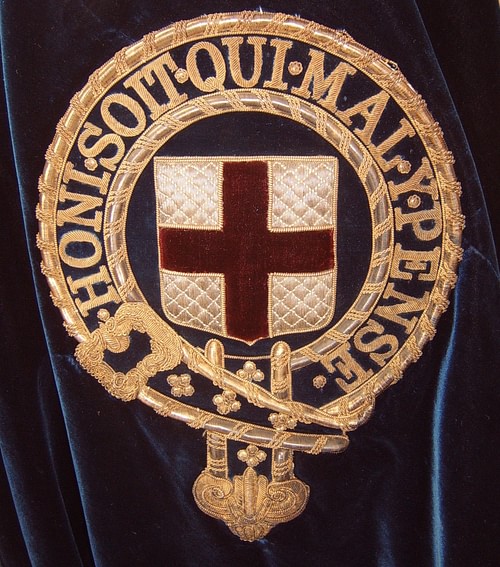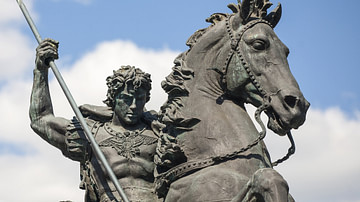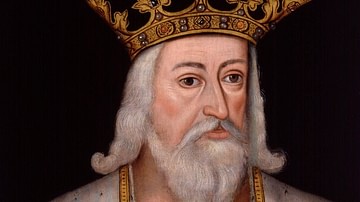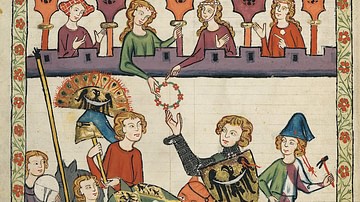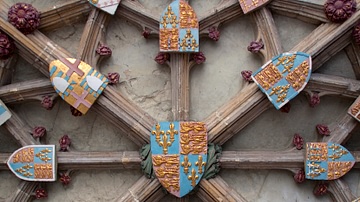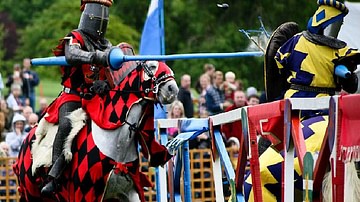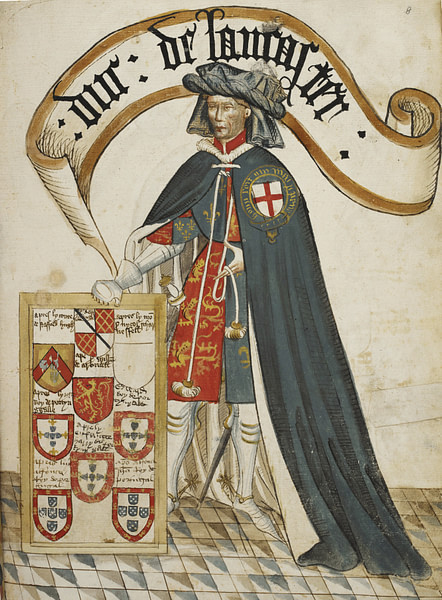
The Most Noble Order of the Garter is the highest order of knighthood in Britain and the most exclusive with traditionally only 24 knights as full members at any one time, along with the reigning monarch and the Prince of Wales. Created by Edward III of England c. 1348 CE, the chivalric order was one of the first of a growing trend where rulers and noble knights sought to differentiate themselves from the increasing number of knights in the late medieval period. The order's annual gathering at Saint George's Chapel at Windsor Castle, with its magnificent procession of members and retainers in full regalia, maintains the traditions of pomp and pageantry for which the Middle Ages are rightly famous.
Origins
The Order of the Garter was created by the English monarch Edward III (r. 1327-1377 CE) around 1348 CE and dedicated to the Virgin Mary and Saint George. The king was still in a celebratory mood after England's famous victory over a much bigger French army at the Battle of Crécy in August 1346 CE and was eager to further emphasise the nation's martial prowess by creating an elite order of knights. In addition, by the 14th century CE, the number of knights had greatly increased so that the upper ranks of the nobility began to look for some way in which they could differentiate themselves from other knights and create a sort of private members club. These elite brotherhoods were designed to also pull together the greatest fighters and most useful military knowledge and experience so that in times of war the order would prove a useful part of the army's command structure. Finally, such secular chivalric orders were a good way for a sovereign to ensure the loyalty of their best knights who otherwise may have joined an order whose members, instead, swore allegiance to the church (the then-defunct Knights Templar being an example of such an order).
The Order of the Garter was the first of such chivalric orders in England, but there had been several already formed elsewhere, notably the Order of the Sash by King Alfonso XI of Castile and Leon (r. 1313-1350 CE) and the Order of Saint Catherine in France, both founded during the 1330s CE. The pomp and ceremony of the Order of the Garter was something more, though, and it would spawn many other famous orders at home and abroad such as the Order of the Golden Fleece, created by Philip the Good, Duke of Burgundy (1419-1467 CE) in 1430 CE.
Just like the legendary Round Table of King Arthur, the order of the Garter was, from the outset, intended to be a very exclusive club indeed. Its first two members were Edward III himself and his son, Edward the Black Prince and Prince of Wales. Alongside this pair were 24 knights, known as Companions of the Order of the Garter, all of whom had fought at the Battle of Crécy. Each member was granted the right to wear a dark blue garter as a symbol of their membership and new rank. A specific coat of arms was created for the order, which includes the flag of Saint George enclosed in a circle made up of a garter. Besides the knights, there were 26 priests and 26 'poor knights' (faith and charity being great chivalric ideals) who were expected to pray for the souls of the more illustrious full members, although they did receive free clothes, food, and lodgings at Windsor castle.
Symbols & Costume
There was not much point in being a member of an exclusive set unless one could show the fact off, and there are various theories as to just why a garter was selected as the order's emblem. One view is that it is not actually a garter at all but a sword belt, and it is true that in many depictions of the order's arms the garter has a buckle. The more romantic (and later) explanation for the origin of the garter involves a certain ball in Calais, France. At this party, a lady, possibly Joan, Countess of Salisbury, was unfortunate enough to have lost her garter on the dance floor. King Edward III was in attendance at this ball and, seeing the mishap, he chivalrously collected the garter and uttered the following comment:
Honi soit, qui mal y pense
or
Evil be on him who thinks it.
These words now appear within the blue garter of the order's emblem, and they may refer to Edward admonishing anyone who drew attention to the mishap at the ball or, more likely, it actually refers to the King's claim of sovereignty over France and admonishes anyone who doubts it. A further connection to France is the colours of the garter which are also those of the French royal arms - blue and gold. However, the earliest depictions of the garter actually show it as mulberry (murrey in heraldic terms). The garter was certainly a practical choice as it could easily be worn on the upper arm by a knight wearing armour. The robes or mantle of the order, worn during ceremonies, was established by the 15th century CE as blue with a garter on the left shoulder. In addition, members were (and still are) expected to wear a real garter on the left leg above the knee when representing the order at official occasions.
As with most regalia, over time the robe became even more splendid. Henry VII (r. 1485-1509 CE) added a collar made up of gold knots and red roses encircled with garters. From the collar (actually a gold necklace) a representation of a mounted Saint George killing his dragon foe is suspended. Nowadays, members also wear a black Tudor bonnet with white ostrich plumage. Then, for those occasions when the full robes are not worn, say on a military dress uniform (see HRH Prince William, the Duke of Cambridge on his wedding day in 2011 CE) there is the star of the order which was introduced by Charles I (r. 1625-1649 CE) in 1629 CE. The star may be worn with a wide blue ribband or sash across the wearer's left shoulder.
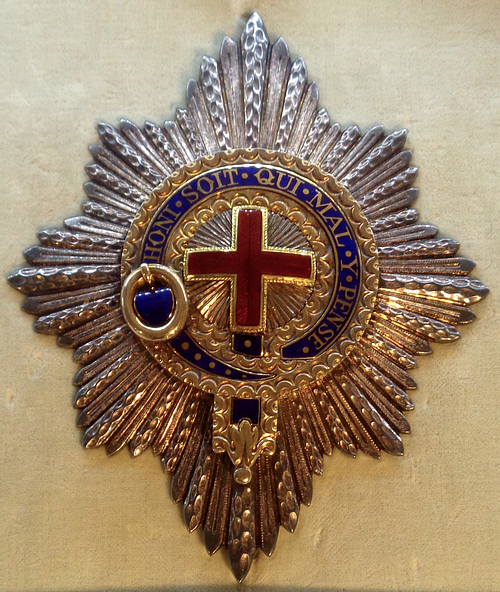
Membership
The Garter King of Arms is the principal king of arms in Britain and most senior herald, responsible for all heraldic matters of the Order of the Garter (and many additional duties besides). The first holder of the office was Sir William Bruges in the mid-15th century CE. In official ceremonies involving other heralds, he is identified by his badge and gold sceptre which carries the flag of Saint George, the royal arms, and a crown. The Garter King of Arms is responsible for the administration of the order, although the appointment of members remains the right of the reigning monarch. For the first two centuries of the order's history only those with martial experience were eligible, but even today there is always a good number of the 24 knights who once held senior positions in the armed forces.
New members are invested into the order in the Throne Room of Windsor Castle. Accompanied by two knights who sponsor them, the monarch gives the robes and insignias of membership, and a garter is tied around the inductee's left leg and held in place by the Garter King of Arms while the following admonition is read out:
To the honour of God Omnipotent and in Memorial of the Blessed Martyr, Saint George, tie about they leg, for thy renown, this most Noble Garter. Wear it as a symbol of the Most Illustrious Order, never to be forgotten or laid aside, that thereby thou mayest be admonished to be courageous, and having undertaken a just war, with which thou shalt be engaged, thou mayest stand firm, valiantly fight courageously and successfully conquer. (Slater, 158)
In the medieval ceremony, knights of the Garter had to swear to certain rules of behaviour such as never fighting on opposing sides, never to leave England without the king's permission, and to always wear the garter at tournaments and battle.
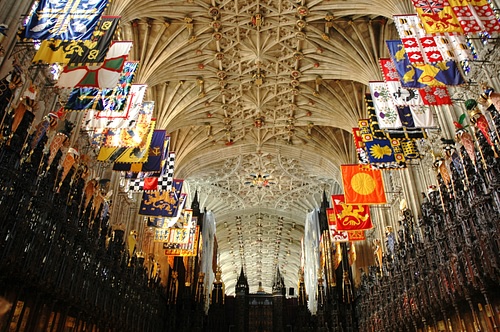
Although membership is still limited to 24 knights today, there are a few extras known as supernumerary members, who usually include additional members of the royal family and selected foreign sovereigns and former politicians. Women were associated with the order in medieval times, and although they were not considered full members of the order, they could wear the garter on their left arm, as seen in several tomb effigies. The last woman to be so privileged was the mother of Henry VII, Margaret Beaufort (d. 1509 CE). Thereafter, only men could be members of any kind, except queens. From 1987 CE the order accepted women as members again, this time with full rights and known as Lady Companions of the Most Noble Order of the Garter. The former Prime minister Margaret Thatcher was made a member, for example.
Aside from the splendid finery members of the order may wear, they are also entitled to put the letters KG after their name and add “Sir” or “Lady” to their forename. Other perks include automatic invites to certain state events, including royal weddings, for example. A heraldic perk is to have the right to add the garter emblem to the family coat of arms (achievement) and add retainers to it (the figures who stand either side of the central shield). The coat of arms of a member, which may have to be created by the Royal College of Arms if the holder does not yet have one, is hung in Saint Georges' chapel in Windsor Castle, the religious headquarters, as it were, of the order. The flag hangs above the member's private stall in the church which is also indicated by a metal plaque bearing their name. The flag is removed when a member of the order dies, but the plaques always remain and so provide an interesting record of past membership.
Saint George's Chapel hosts the great annual gathering of the order, held on a Monday in mid-June. If there are to be any new knights invested in the order, there is a morning service in the Throne Room of Windsor Castle. After lunch, a magnificent procession with all members in their full regalia winds through Windsor Castle from Saint George's Hall to the chapel. The display of medieval pageantry is rivalled only by such royal occasions as a coronation and is a marvellous example of the continuity of medieval traditions in Britain.
